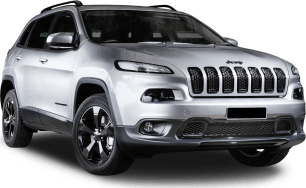As standard both the front seats in the top-spec Haval H6 Ultra have electric adjustment. In particular, the driver’s seat has six ways of electric adjustment, plus adjustable lumbar support.
The driver’s seat itself is comfortable enough, though on longer drives I look for a little more thigh support. You’re unable to adjust either front seat to get more thigh support.
However, there’s both heating and ventilation as standard for both front seats. The steering wheel is also heated which has been a godsend in the cold Melbourne weather.
The buttons on the new thicker steering wheel now control different functions. There’s no longer a stalk dedicated to the cruise control, instead this is now done on the steering wheel itself.
Also on the right-hand side of the steering wheel there are still buttons that change the volume, but when you click just above the volume rocker it changes their function to altering what’s on the digital instrument cluster. I’m sure you’d get used to this if you owned this car, but initially it messes with your head.
Another thing is given the gear selector is now behind the steering wheel, the wiper controls are now on the indicator stalk. This now also means there’s no proper buttons or stalk to adjust the headlights.
Instead you need to either use the touchscreen or press the ‘auto’ button on the dashboard. Unless you frequently change your headlight settings, this likely won’t be an issue.
The 10.25-inch digital instrument cluster now has updated graphics and looks high-resolution. The interface is still dark, however, and you can only adjust the content on the right-hand side.
Moving across the larger touchscreen multimedia system looks fantastic and is a breeze to navigate thanks to the shortcut keys on the right and the handy swipe-down control centre menu.
There’s now wireless Apple CarPlay and Android Auto functionality in this car which is fantastic to see. It’s particularly good because if you want to use the wired version of either, the USB-A port to access this is still on the passenger side of the centre console.
However, while you’re using smartphone mirroring you can’t access the handy swipe-down control centre menu. You need to exit and go back to the native interface to use it, which completely undermines its existence.
Another gripe is there still aren’t many physical buttons around the H6's cabin, with only a few for select climate control functions. To change the temperature, for example, you either need to use the touchscreen or the voice assistant, which isn’t always intuitive.
Thanks to the relocation of the gear selector, storage in the centre console has improved massively. There are two cupholders, a wireless charger that now features ventilation to keep your phone cool, as well as another storage nook for your keys.
Other storage highlights up front include a large space under the centre console, a centre console box, a glovebox, as well as big door pockets with bottle holders.
Moving to the second row, this is where Chinese SUVs shine. At a leggy 182cm I have plenty of space behind my own driving position.
The rear bench is reclined a touch and plenty comfortable enough for longer trips. You could easily fit three adults in the back thanks to the minimal centre tunnel intrusion.
Second-row amenities include centre console-mounted air vents, a USB-A and USB-C port, as well as a fold-down armrest with cupholders.
At the back there’s now a hands-free power tailgate that’s standard across the line-up, except for the entry-level H6 Lux petrol trim. It’s very easy to use and particularly handy if you’ve got full hands.
The boot area in the Haval H6 is decent and there’s no load lip, making lugging items in and out a lot easier. GWM claims there’s 560L of boot space with the rear seats upright, which is great for the segment.
There are few boot-related amenities besides a single hook, 12V socket and a cargo blind.
Disappointingly there’s no spare wheel under the boot floor of the H6 Hybrid. Instead there’s only a tyre repair kit, which is surprisingly common among hybrids as the space where a spare wheel would typically go is taken up by the high-voltage battery pack.





.png)










































 copy.png)












